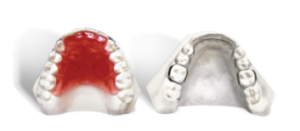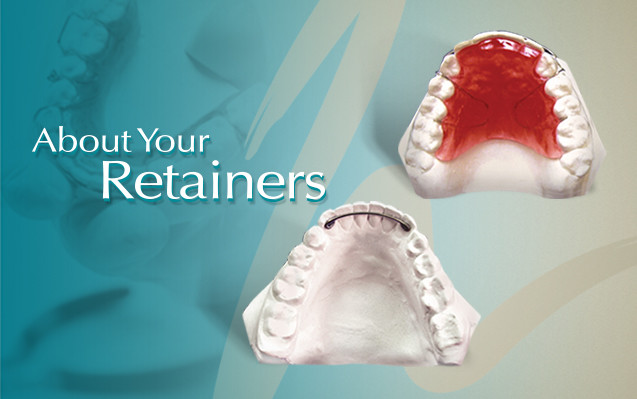Orthodontic Retainer for Braces Treatment
Once braces come off, an orthodontic retainer is needed to complete treatment and keep teeth in place. When teeth are moved with braces, there are forces in the mouth that will cause the teeth to drift back toward their original position. Such drifting is called relapse. In order to prevent relapse, orthodontic retainers are used.
FAQ’s about orthodontic retainers
How long will I need to wear an orthodontic retainer?
Each case is unique and it depends on individual circumstances. However, in most cases, the upper orthodontic retainer will be worn for 2-2 ½ years full time (24 hours wear). After that, the upper retainer will be worn just sleeping for an additional 2-2 ½ years. The lower retainer will be used 6-8 years. After that, the upper retainer will be worn at night and the lower retainer will not show throughout the retention period.
How often do I have to be seen by the orthodontist?
Unlike braces, you will not need to be seen very often with your retainers. We typically see you at 3-6 month intervals the first year. During the second year of retention, we will see you at 6 month intervals. After the second year, you will be checked once a year.
What do retainers look like?
The upper retainer is removable and fits into the roof of the mouth. The part that shows is the wire that goes across the front teeth.
Most of our lower retainers are permanently attached to the teeth because of the movement of the tongue, which tends to dislodge the retainer. Because the lower retainer is behind the teeth, it will not show.
How do I take care of my retainers?
Upper – The upper orthodontic retainer should be brushed with a toothbrush and toothpaste at least once a day. Please avoid constant “clicking” of the retainer in and out. This will weaken the wires which may result in premature breakage.
Lower – The lower retainer should be brushed and flossed when you brush your teeth. The lower retainer will be checked at each appointment. If it should become loose between visits please call the office to have it re-attached.
When do I take out the upper retainer?
During the first 2-2 ½ years you will be requested to wear the upper retainer full time, including eating. The only time it should be taken out is to brush the teeth and the retainer. Then it should be immediately reinserted.
After 2- 2 ½ years you will be given the okay for nighttime wear. This means you would only be wearing it to sleep.
Should I take the upper retainer out to eat?
In our experience most retainers are lost or broken when they are taken out to eat. This is the reason we suggest they not be taken out while eating. We will carefully adjust your retainer to allow use while eating.
What if I lose my retainer?
It can happen to anyone. If the retainer is lost, please call the office for an appointment as soon as possible. If the retainer is still necessary, it will be replaced at a orthodontic fee. If the retainer is no longer required, it may not need to be replaced. The doctor will make this determination at your appointment.
What if the retainer breaks?
If the retainer breaks please call the office as soon as possible for an appointment. Please remember to bring your retainer to the appointment. The doctor will determine if the retainer is still required. If it is still required, we will determine if the breakage can be repaired. Depending on the type and severity of the repair there may be a fee. If the breakage is too severe, and the retainer is not repairable; we will make a new retainer. Depending on the circumstances there may be a replacement fee for the new retainer.
What if I have a dog?
Your dog is attracted to your smell. Therefore, if you leave the retainer where your pet can get it, your dog will chew up your retainer. If your dog does chew up the retainer, call the office for an appointment. If the damage is less extensive, we may be able to repair the retainer. Bring the retainer to the appointment for an evaluation. If the breakage is too severe,a new retainer will need to be made at a fee.
What about Wisdom teeth?
Many of our patients will be retained during their teenage years. During the period of retainer wear we will monitor the wisdom teeth (as will your general dentist) to determine if there will be enough space to accommodate these teeth. Studies show most people end up having the wisdom teeth removed.
What if I do not wear the retainers as instructed?
Simply put, if you do not wear orthodontic retainers as instructed, you may find yourself requiring braces a second time. If retainers are not worn properly the teeth can shift. This shifting is called relapse. The amount of relapse will vary from case to case. The general rule is: the greater the misalignment at the start of treatment, the greater the relapse if the retainers are not worn properly.
A note of caution, relapse tends to occur very slowly and by the time it becomes noticeable the teeth may have moved significantly. In such cases it may become necessary to reapply the braces to correct the relapse. Such re-treatment would incur additional cost.
If you have questions about your orthodontic retainer, contact one of our three Akron area Haas Orthodontic Arts offices today.

